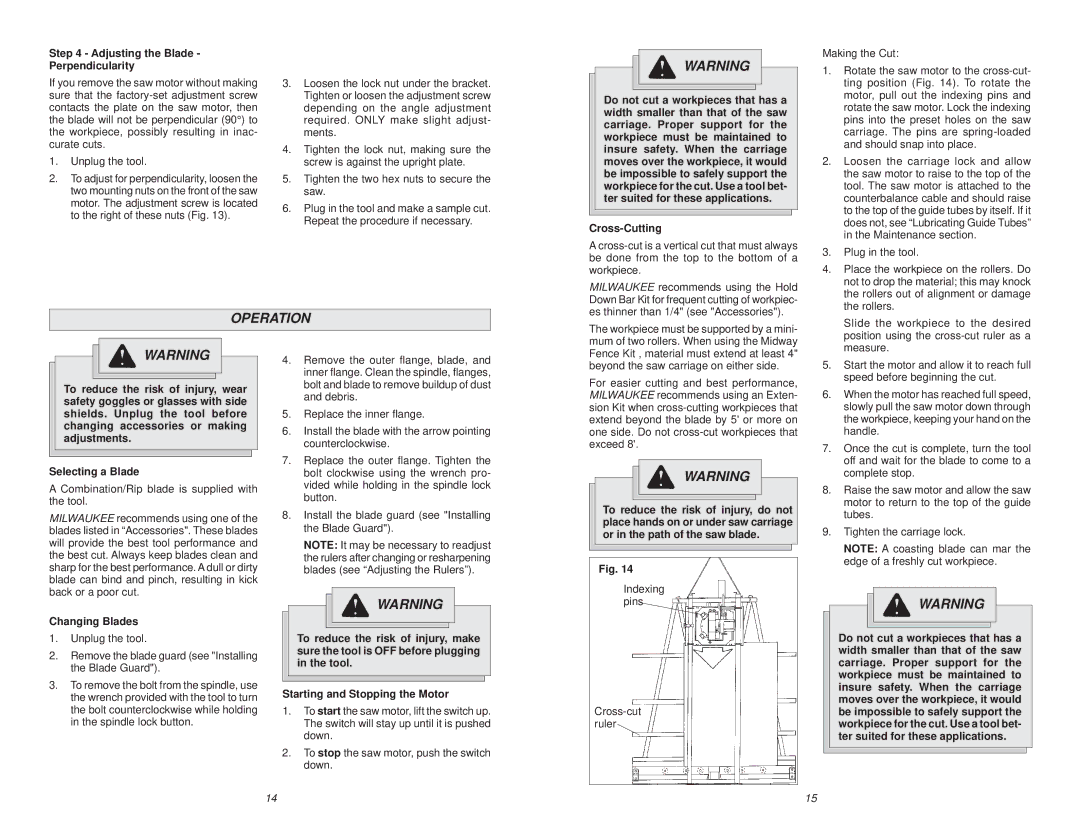
Step 4 - Adjusting the Blade -
Perpendicularity
If you remove the saw motor without making sure that the
1.Unplug the tool.
2.To adjust for perpendicularity, loosen the two mounting nuts on the front of the saw motor. The adjustment screw is located to the right of these nuts (Fig. 13).
3.Loosen the lock nut under the bracket. Tighten or loosen the adjustment screw depending on the angle adjustment required. ONLY make slight adjust- ments.
4.Tighten the lock nut, making sure the screw is against the upright plate.
5.Tighten the two hex nuts to secure the saw.
6.Plug in the tool and make a sample cut. Repeat the procedure if necessary.
![]() WARNING
WARNING
Do not cut a workpieces that has a width smaller than that of the saw carriage. Proper support for the workpiece must be maintained to insure safety. When the carriage moves over the workpiece, it would be impossible to safely support the workpiece for the cut. Use a tool bet- ter suited for these applications.
Cross-Cutting
A
Making the Cut:
1. | Rotate the saw motor to the |
| ting position (Fig. 14). To rotate the |
| motor, pull out the indexing pins and |
| rotate the saw motor. Lock the indexing |
| pins into the preset holes on the saw |
| carriage. The pins are |
| and should snap into place. |
2. | Loosen the carriage lock and allow |
| the saw motor to raise to the top of the |
| tool. The saw motor is attached to the |
| counterbalance cable and should raise |
| to the top of the guide tubes by itself. If it |
| does not, see “Lubricating Guide Tubes” |
| in the Maintenance section. |
3. | Plug in the tool. |
4. | Place the workpiece on the rollers. Do |
| not to drop the material; this may knock |
OPERATION
MILWAUKEE recommends using the Hold Down Bar Kit for frequent cutting of workpiec- es thinner than 1/4" (see "Accessories").
the rollers out of alignment or damage |
the rollers. |
Slide the workpiece to the desired |
![]() WARNING
WARNING
To reduce the risk of injury, wear safety goggles or glasses with side shields. Unplug the tool before changing accessories or making adjustments.
Selecting a Blade
A Combination/Rip blade is supplied with the tool.
MILWAUKEE recommends using one of the blades listed in “Accessories". These blades will provide the best tool performance and the best cut. Always keep blades clean and sharp for the best performance. A dull or dirty blade can bind and pinch, resulting in kick back or a poor cut.
Changing Blades
1.Unplug the tool.
2.Remove the blade guard (see "Installing the Blade Guard").
3.To remove the bolt from the spindle, use the wrench provided with the tool to turn the bolt counterclockwise while holding in the spindle lock button.
4.Remove the outer flange, blade, and inner flange. Clean the spindle, flanges, bolt and blade to remove buildup of dust and debris.
5.Replace the inner flange.
6.Install the blade with the arrow pointing counterclockwise.
7.Replace the outer flange. Tighten the bolt clockwise using the wrench pro- vided while holding in the spindle lock button.
8.Install the blade guard (see "Installing the Blade Guard").
NOTE: It may be necessary to readjust the rulers after changing or resharpening blades (see “Adjusting the Rulers”).
![]() WARNING
WARNING
To reduce the risk of injury, make sure the tool is OFF before plugging in the tool.
Starting and Stopping the Motor
1.To start the saw motor, lift the switch up. The switch will stay up until it is pushed down.
2.To stop the saw motor, push the switch down.
The workpiece must be supported by a mini- mum of two rollers. When using the Midway Fence Kit , material must extend at least 4" beyond the saw carriage on either side.
For easier cutting and best performance, MILWAUKEE recommends using an Exten- sion Kit when
WARNING
To reduce the risk of injury, do not place hands on or under saw carriage or in the path of the saw blade.
Fig. 14
Indexing pins
| position using the |
| measure. |
5. | Start the motor and allow it to reach full |
| speed before beginning the cut. |
6. | When the motor has reached full speed, |
| slowly pull the saw motor down through |
| the workpiece, keeping your hand on the |
| handle. |
7. | Once the cut is complete, turn the tool |
| off and wait for the blade to come to a |
| complete stop. |
8. | Raise the saw motor and allow the saw |
| motor to return to the top of the guide |
| tubes. |
9. | Tighten the carriage lock. |
| NOTE: A coasting blade can mar the |
| edge of a freshly cut workpiece. |
![]() WARNING
WARNING
Do not cut a workpieces that has a width smaller than that of the saw carriage. Proper support for the workpiece must be maintained to insure safety. When the carriage moves over the workpiece, it would be impossible to safely support the workpiece for the cut. Use a tool bet- ter suited for these applications.
14 | 15 |
